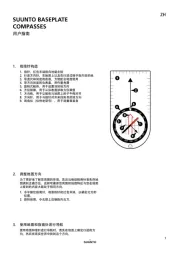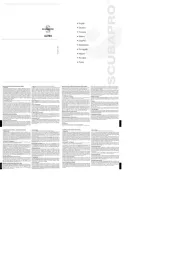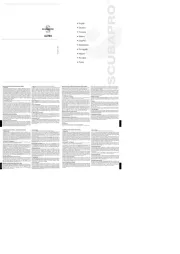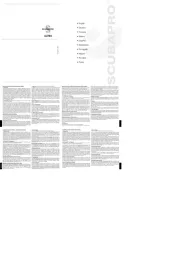
®
SCUBAPRO
Compass Manual
www.scubapro.com
Copyright by SCUBAPRO UWATEC AG Switzerland 9.04
INSTRUCTIONS D’UTILISATION DU COMPAS SCUBAPRO UWATEC
Les compas SCUBAPRO UWATEC ont été conçus et fabriqués avec la plus gran-
de rigueur afin d’assurer une très grande précision pendant très longtemps.
Ils sont quasiment insensibles à la pression étant remplis d’huile et étanches. Com-
me tous les compas sensibles, le compas SCUBAPRO UWATEC est sujet aux
déviations causées par des masses métalliques. C’est pour cette raison que lors-
que le compas est utilisé seul, il doit être porté sur le poignet qui ne comporte pas
d’autres instruments métalliques (comme une montre ou un ordinateur). Lorsque le
compas est monté dans une console Scubapro ou SCUBAPRO UWATEC, ou sur
une ardoise, il est important de s’assurer que le ou les autres instruments
n’influencent pas le compas.
1 .1 FS-2 and FS-1 compasses
P/N 05.016.001 (FS-1 Hémisphère Nord), 05.016.002 (FS-1 Hémisphère Sud),
05.017.001 (Modèle FS-2 utilisable dans les deux hémisphères).
Les modèles FS-2 et FS-1 sont des compas à lecture verticale et latérale. La lunet-
te tournante de référence de cap est utilisée pour une navigation avec lecture
verticale. Afin d’avoir les plus gros chiffres possibles, le zéro des degrés a été en-
levé de la lunette. En conséquence, le chiffre 3 représente 30 degrés, le chiffre 27
représente 270 degrés. Les chiffres sont présents tous les 30 degrés, avec une
petite ligne tous les 10 degrés. Un clic est perceptible à chaque rotation de la lu-
nette de 5 degrés.
La surface sensible au champ magnétique est incurvée en périphérie pour per-
mettre une lecture verticale et latérale. Les chiffres sur cet élément sont complets
et encore une fois sont espacés de 30 degrés avec de petites lignes tous les 10
degrés. Ces composants disposent d’une certaine liberté de mouvement pour
permettre l’utilisation du compas FS-1 selon un angle de gîte allant jusqu’à 15
degrés. Le modèle FS-2 est doté d’un angle de gîte unique de 35 degrés.
Utilisation du compas : lecture verticale
Avant tout, prendre un relèvement, la ligne de foi visant le point de référence. At-
tendre la stabilisation de la rose qui indiquera le nord. Aligner la couronne avec
rose. Dès que vous commencez à nager, tenez le compas pour que la ligne de foi
soit en alignement avec la direction de la nage tout en maintenant la rose en alig-
nement avec la couronne.
Utilisation du compas : lecture latérale
Prendre un relèvement, la ligne de foi visant le point de référence. Attendre la sta-
bilisation de la rose qui indiquera le nord. La ligne de foi est prolongée sur la fenêt-
re latérale pour une lecture plus précise. Dès que vous commencez à nager, tenez
le compas pour que la ligne de foi soit en alig-nement avec la direction de la nage
tout en maintenant les chiffres représentant le cap à suivre en alignement avec la
ligne de foi.
1.2 Compas C-1
P/N 05.015.000 (en console), 05.015.100 (en bracelet poignet)
Le compas C-1 est un compas compact, à lecture verticale et à réponse rapide.
Sa taille réduite ne pénalise pas sa performance. La partie du compas sensible au
champ magnétique est intégrée à l’aiguille qui est très légère et de petite taille pour
procure une réponse très rapide. Ce compas utilise un double pivot permettant un
angle de gîte de plus de 50 degrés.
La couronne réglable est utilisée pour une lecture verticale du cap à suivre. Les
quatre points cardinaux sont indiqués sur la couronne, mais à cause de la taille
réduite, les chiffres ont été remplacés par des points tous les 30 degrés. Les chiff-
res sont reportés sur le fond du compas tous les 30 degrés. L’aiguille se déplace
au dessus de ce fond. Afin d’avoir les plus gros chiffres possibles, le zéro des de-
grés a été enlevé fond. En conséquence, le chiffre 3 représente 30 degrés, le
chiffre 27 représente 270 degrés.
Utilisation du compas :
Se mettre en alignement avec le point de référence, puis, aligner la couronne avec
l’aiguille et lire les chiffres correspondant à la direction de ce point. Commencez à
nager dans la direction désirée tout en gardant l’aiguille en alignement avec la
couronne.
2. Entretien
Le compas SCUBAPRO UWATEC n’est pas un instrument délicat. Il a été étudié,
conçu et fabriqué pour résister aux conditions normales rencontrées en plongée.
Toutefois, comme chaque pièce de matériel de plongée, il est susceptible d’être
endommagé par des chocs, et en conséquence, une attention raisonnable doit lui
être portée. Un rinçage abondant du compas après utilisation est la seule recom-
mandation requise.
Si le compas est utilisé dans de l’eau chargée en sédiments et en sable, le rinçage
abondant devient alors très important pour une rotation en souplesse de la lunette.
2.1 Entretien spécial
Le compas SCUBAPRO UWATEC requiert un entretien plus poussé lorsqu’il est
utilisé dans de l’eau chlorée (en piscine). Après chaque plongée en piscine, le
compas SCUBAPRO UWATEC doit être rincé abondamment à l’eau douce et en-
suite séché avant d’être stocké.
3. Garantie de 2 ans limitée
SCUBAPRO UWATEC garantie le compas de tous défauts de fabrication, pièces
et main d’œuvre, au premier propriétaire, pour une période de 2 ans à partir de la
date d’achat. Cette garantie est annulée si le compas SCUBAPRO UWATEC n’a
pas été acheté chez un agent agrée SCUBAPRO UWATEC. Pour faire une deman-
de de prise en garantie, retournez votre compas accompagné de la preuve d’achat
à votre revendeur agréé SCUBAPRO UWATEC.
Français
MANUALE ISTRUZIONI BUSSOLE SCUBAPRO UWATEC
1. Descrizione
Le bussole SCUBAPRO UWATEC sono progettate e realizzate secondo i più
elevati standard di qualità per assicurare un funzionamento accurato, affidabile e
costante nel tempo. Questi strumenti sono praticamente insensibili alla pressione
grazie all'olio contenuto all'interno e all'isolamento dall'ambiente esterno. Come
qualsiasi bussola ad elevata sensibilità, anche le bussole SCUBAPRO UWATEC
sono soggette alle deviazioni causate dall'effetto dei materiali metallici. Per questa
ragione quando si utilizza una bussola da polso si deve avere cura di indossarla da
sola su un braccio, allacciando gli altri strumenti dotati di elementi metallici
(computer, orologio, profondimetro) sul braccio opposto. Quando la bussola è
inserita in una console, o applicata ad una lavagnetta, prodotti da SCUBAPRO o
SCUBAPRO UWATEC questo problema non si presenta in quanto durante la
progettazione si provvede ad assicurare che la bussola non sia influenzata dalla
prossimità degli altri componenti.
1.1 Le bussole FS-2 e FS-1
PN 05.016.001 (FS-1 Emisfero Nord), 05.016.002 (FS-1 Emisfero Sud) 5.017.001
(FS-2 Emisfero universale).
Le Bussole FS-1 e FS-2 sono modelli a lettura laterale e dall'alto. La ghiera rotante
d’impostazione della rotta viene impiegata per effettuare il puntamento della rotta
da seguire. E' stato tolto lo zero finale dai riferimenti numerici disposti sulla ghiera
in modo da poter impiegare numeri più grandi e quindi più leggibili. Di conseguenza
la cifra 3 indica 30 gradi, 27 indica 270 gradi e così via. I riferimenti numerici sono
posizionati ogni 30 gradi, con una linea ogni 10. Ruotando la ghiera è possibile
avvertire uno scatto, ogni scatto corrisponde ad una rotazione di 5 gradi.
L'elemento sensibile al campo magnetico è curvato lungo la sua circonferenza, in
modo da consentire sia la lettura dall'alto che quella laterale. I riferimenti numerici
presenti su questo elemento sono disposti ad intervalli di 30 gradi, con linee ogni
10. La piattaforma dell'ago è dotata di una certa libertà di movimento, in questo
modo la bussola FS-1 può essere utilizzata anche se inclinata fino a 15 gradi
dall'orizzontale e la FS-2 fino a 35 gradi.
Utilizzo della bussola: lettura dall'alto
Per prima cosa individuare la direzione da seguire: puntare la linea di fede verso un
punto di riferimento ed attendere che l'ago smetta di muoversi per individuare il
nord. A questo punto ruotare la ghiera fino ad allineare l’ago con il riferimento N
sulla ghiera stessa. Nuotare avendo cura di mantenere la linea di fede allineata alla
propria direzione di movimento e assicurarsi che l'ago rimanga allineato al
riferimento N sulla ghiera.
Utilizzo della bussola: lettura laterale
Individuata la direzione da seguire: puntare la linea di fede sulla rotta prescelta,
attendere che l'ago smetta di ruotare e leggere la cifra riportata sulla piattaforma
dell'ago. Per consentire una lettura più accurata la linea di fede è riportata anche
sulla finestra di lettura laterale. Nuotare tenendo la bussola in posizione tale che la
linea di fede sia allineata alla direzione di movimento e la cifra che indica la rotta
prescelta allineata con la linea di fede della finestra di lettura laterale.
1.2 Bussola C-1 PN 05.015.000 (In console), 05.015.100 (A polso)
La Bussola C-1 è uno strumento a lettura dall'alto e a risposta rapida. Le sue
dimensioni compatte non comportano una riduzione delle prestazioni. L'elemento
sensibile al campo magnetico è incorporato all'ago ed il peso e le dimensioni
ridotte di quest'ultimo consentono una risposta eccezionalmente rapida alle
variazioni di rotta. Inoltre l'adozione di un doppio supporto per l'ago assicura un
funzionamento corretto della bussola anche se inclinata fino a 50 gradi
dall'orizzontale. La ghiera ruotante viene utilizzata per fornire un riferimento alla
rotta da seguire nella lettura dall'alto. La ghiera riporta i quattro punti cardinali,
mentre i riferimenti numerici sono stati sostituiti da indicatori grafici (punti) disposti
ogni 30 gradi, consentendo di assicurare una buona leggibilità nonostante le
dimensioni contenute. Sul quadrante sottostante all'ago sono riportati riferimenti
numerici disposti in incrementi di 10 gradi. Per consentire l'uso di cifre di grandi
dimensioni –e quindi agevolare la lettura- è stato rimosso lo zero finale dai
riferimenti del quadrante. Di conseguenza la cifra 3 indica 30 gradi, 27 indica 270
e così via.
Utilizzo della bussola: Posizionarsi in direzione del punto di riferimento prescelto,
allineare il N della ghiera con l'ago e leggere l'indicazione numerica che corrisponde
alla rotta desiderata. Nuotare in tale direzione mantenendo l'ago allineato al N della
ghiera.
2. Cura e manutenzione
Le bussole SCUBAPRO UWATEC non sono strumenti delicati. Sono state
pensate, progettate e realizzate per sopportare i rigori tipici dell'attività subacquea
professionale, nondimeno, come per ogni altro componente dell'attrezzatura, urti
o altre sollecitazioni meccaniche violente possono danneggiarle, quindi è
opportuno evitarle. La manutenzione dopo l'uso è limitata ad un accurato
risciacquo in acqua dolce. Il risciacquo diventa particolarmente importante per
garantire una rotazione agevole della ghiera dopo l'uso in acque ricche di sabbia o
fango in sospensione.
2.1 Manutenzione straordinaria
Le bussole SCUBAPRO UWATEC richiedono una manutenzione particolare solo
quando utilizzate in acque clorate (piscina) a causa degli effetti dannosi che il cloro
può determinare sui componenti dello strumento. Dopo ogni utilizzo in piscina le
bussole SCUBAPRO UWATEC devono essere accuratamente sciacquate in acqua
dolce e lasciate asciugare completamente prima di riporle.
3. Garanzia due anni
Per due anni dalla data di acquisto SCUBAPRO UWATEC garantisce, al primo
proprietario, la bussola esente da difetti dei materiali o di fabbricazione, quando
sottoposta ad uso normale ed assistita da un’adeguata manutenzione. Per
usufruire della garanzia portare o inviare la bussola al proprio rivenditore autorizzato
SCUBAPRO UWATEC corredata da una prova di acquisto in data certa (es.:
scontrino fiscale).
Italiano
SCUBAPRO UWATEC COMPASS INSTRUCTION
1. Description
SCUBAPRO UWATEC compasses are designed and manufactured to the highest
standards to ensure accurate and reliable performance over a long period of time.
They are virtually unaffected by pressure because they are oil-filled and sealed from
the environment. Just as any sensitive compass, SCUBAPRO UWATEC compasses
are subject to deviations due to metallic influences. For this reason a compass, when
used in its stand-alone wrist mount, should be worn on an arm by itself, and all other
metallic instrumentation (watches, computers, depth gauges) on the other arm.
When the compass is used in a SCUBAPRO UWATEC instrument console or writing
slate, care has been taken in the development of the console or slate itself to ensure
that the compass is not influenced by the other instrument(s). All-Hemisphere
Advanced Tilt).
1.1 FS-2 and FS-1 compasses
PN 05.016.001 (FS-1 Northern Hemisphere), 05.016.002 (FS-1 Southern
Hemisphere), 05.017.001 (FS-2 Universal Hemispheres).
The FS-2 and FS-1 compasses are top-reading and side-reading compasses. The
course-setting bezel is used to give the top-reading target line reference. To allow
the largest possible digits (for maximum readability), the ending zero has been
removed from the numerals on the bezel itself. Therefore the numeral 3 represents
30 degrees, 27 represents 270 degrees, and so on. Numerals are given every 30
degrees, with a small line every 10 degrees. A click can be felt when turning the
bezel. Each click corresponds to a 5 degree rotation.
The magnetic-field sensitive portion of the compass (floating element) is curved at
the edges to allow for top and side reading. The numerals on this component
comprise all digits, and again are spaced at 30 degree intervals, with small lines
every 10 degrees. These components have a certain degree of freedom of
movement, so that the FS-1 compass can be used at a tilt angle of up to 15
degrees and the FS-2 provides a unique tilt angle of 35 degrees.
Using the compass: top reading
First take a compass heading: point the lubber line towards your reference point
and wait for the floating element to stop in its motion to indicate north. Now line up
the bezel with the floating element. Once you start swimming, hold the compass
so that the lubber line is aligned with your swimming direction while keeping the
floating element aligned with the bezel.
Using the compass: side reading
Take a compass heading by pointing the lubber line at your reference point and
reading the digits on the floating element once it has stopped moving. The lubber
line is extended to the side window for more accurate reading. Once you start
swimming, hold the compass so that the lubber line is aligned with your swimming
direction while keeping the digits representing your course aligned with the side
lubber line.
1.2 C-1 compass
PN 05.015.000 (console mount), 05.015.100 (wrist strap mount)
The C-1 compass is a compact, fast response top-reading compass. Its reduced
size does not imply reduced performance. The magnetic-field sensitive portion of
the compass is built into the needle, and the reduced size and weight of the needle
are responsible for a very fast response. In addition, double bearing of the needle
means it works even at tilt angles over 50 degrees.
The course-setting bezel is used to give the top-reading target line reference. The
four cardinal points are indicated on the bezel, but due to the reduced size,
numerals in between have been replaced with dots every 30 degrees. Numerals in
30 degree increments are reported on the face plate over which the needle moves.
To allow the largest possible digits (for maximum readability), the ending zero has
been removed from the numerals on the plate itself. Therefore the numeral 3
represents 30 degrees, 27 represents 270 degrees, and so on.
Using the compass: Align yourself with your reference point, then align the bezel
with the needle and read the numerals corresponding to the direction of your
reference point. While swimming in the direction indicated by the numerals, keep
the bezel aligned with the needle.
2. Care and maintenance
The SCUBAPRO UWATEC compass is not a delicate instrument. It has been
designed, engineered and manufactured to withstand the normal abuses that are
common to the diving profession. However, as with any piece of equipment, it is
subject to damage by violent external abuse and reasonable care should be
exercised in that regard. That and a thorough rinsing after use is all the maintenance
that is required.
If the compass is used in very sandy or muddy conditions, thorough rinsing
becomes very important in order to keep the bezel turning smoothly.
2.1 Special maintenance
The SCUBAPRO UWATEC compass requires special maintenance when used in
chlorinated waters (such as in swimming pools) due to the detrimental effects that
chlorine may have on the various materials used. After each use in a swimming
pool the SCUBAPRO UWATEC compass must be thoroughly rinsed in fresh water
and allowed to dry completely before storing.
3. Limited two-year warranty
SCUBAPRO UWATEC warrants to the original purchaser that for a period of two
years from the date of purchase, the SCUBAPRO UWATEC compass will be free
from defects in materials and workmanship under normal use and with reasonable
maintenance. This warranty is void if the compass was not purchased at an
authorized SCUBAPRO UWATEC dealer. To make a warranty claim, send your
compass with a date receipt to your SCUBAPRO UWATEC dealer.
English
SCUBAPRO UWATEC-KOMPASS - BEDIENUNGSANLEITUNG
1. Beschreibung
SCUBAPRO UWATEC-Kompasse entsprechen höchsten konzeptions- und
fertigungstechnischen Standards und gewährleisten so über einen langen Zeitraum
hinweg Präzision und Zuverlässigkeit. Dank der Ölfüllung und der kompletten
Versiegelung sind sie praktisch druckstabil. Wie jeder Kompass, werden auch
SCUBAPRO UWATEC-Kompasse durch metallische Gegenstände abgelenkt. Wenn
das Gerät als Armkompass getragen wird, sollten alle anderen Metallinstrumente wie
Uhren, Computer, Tiefenmesser am anderen Arm getragen werden. Bei Verwendung
des Kompasses in den entsprechend konzipierten SCUBAPRO bzw. SCUBAPRO
UWATEC Instrumenten-konsolen und UW-Schreibtafeln kommt es hingegen zu
keinen Störungen durch andere Instrumente.
1.1 FS-2 und FS-1 Kompasse
PN 05.016.001 (FS-1 Nördliche Halbkugel), 05.016.002 (FS-1 Südliche Halbkugel),
05.017.001 (FS-2 Nördliche und südliche Halbkugeln)
Die FS-1 Kompasse können von oben und von der Seite gelesen werden. Mit Hilfe
des Stellrings können Sie an der Peillinie die Richtung von oben ablesen. Zur
Darstellung grösstmöglicher Ziffern wurde bei den Ziffern des Stellrings die Endnull
weggelassen, so steht die 3 für 30 Grad, die 27 für 270 Grad und so weiter. In
Abständen von 10 Grad sind Markierungen angebracht, alle 30 Grad ist die
Einteilung beschriftet. Der Stellring rastet beim Drehen alle 5 Grad ein.
Der magnetfeldempfindliche Teil des Kompasses, eine schwebende Windrose, ist
an den Seiten gewölbt und ermöglicht so das Peilen von oben und von der Seite.
Auf der Windrose sind die Ziffern, ohne Weg-lassen der Endnull, in Abständen von
30 Grad aufgedruckt. In 10 Grad-Abstand sind mit einem Strich die Zwischenwerte
markiert. Die über einen gewissen Bewegungsspielraum verfügende Windrose
ermöglicht, dass der FS-1 Kompass bei einem Neigungswinkel von bis zu 15 Grad
und der FS-2 bei einem einzigartigen Neigungswinkel von bis zu 35 Grad
eingesetzt werden kann.
Benutzung des Kompasses: Ablesen von oben
Peilen Sie zunächst die Richtung: Richten Sie die Peillinie auf Ihren Bezugpunkt
und warten Sie, bis die Windrose auf Nord ausgerichtet ist. Drehen Sie jetzt den
Stellring bis dessen Nordmarkierung mit dem Norden der Windrose übereinstimmt.
Beim Schwimmen halten Sie den Kompass so, dass die Peillinie mit Ihrer
Schwimmrichtung übereinstimmt. Dabei müssen die Nordmarkierung der
Windrose und die des Stellrings übereinstimmen.
Benutzung des Kompasses: Ablesen von der Seite
Peilen Sie zunächst die Richtung, indem Sie die Peillinie auf Ihren Bezugspunkt
richten. Danach lesen Sie im Seitenfenster auf der Windrose den Kurs ab. Die bis
ins Seitenfenster verlängerte Peillinie ermöglicht optimale Ablesegenauigkeit. Beim
Schwimmen halten Sie den Kompass so, dass die Peillinie mit Ihrer
Schwimmrichtung übereinstimmt. Gleichzeitig muss der im Seitenfenster
angezeigte Kurs gehalten werden.
1.2 C-1 Kompass
PN 05.015.000 (Konsolenmodell), 05.015.100 (Armbandmodell)
Der C-1 Kompass ist ein kompaktes, schnell reagierendes Gerät mit
Aufsichtpeilung. Er ist klein, aber leistungsstark. Der magnetfeldempfindliche Teil
des Kompasses befindet sich in der Nadel, die klein und leicht und damit für die
schnelle Einschwingzeit verantwortlich ist. Ferner ist dank der doppelten Lagerung
der Nadel die Funktionsfähigkeit selbst bei einem Neigungswinkel von über 50
Grad gewährleistet.
Mit Hilfe des Stellrings wird der Kompasskurs festgelegt. Die vier Himmels-
richtungen sind auf dem Stellring angegeben, weitere Markierungen sind (aufgrund
der geringen Gerätegrösse) als Punkte in 30 Grad-Intervallen gesetzt. Auf dem mit
dem Stellring verbundenen Zifferblatt sind in 30 Grad-Schritten Ziffern aufgedruckt,
über denen die Nadel schwingt. Zur Darstellung grösstmöglicher Ziffern wurde die
Endnull auf dem Zifferblatt weggelassen. So steht die 3 steht für 30 Grad, die 27
für 270 Grad usw.
Benutzung des Kompasses: Richten Sie sich und die Markierung auf dem
Kompassgehäuse nach Ihrem Bezugspunkt aus. Drehen Sie den Stellring, bis er mit
der Kompassnadel übereinstimmt. Lesen Sie an der Markierung auf dem
Kompassgehäuse den Kurs ab. Beim Schwimmen in Richtung des Bezugpunktes
muss die Nordmarkierung der Kompassnadel mit der des Stellrings übereinstimmen.
2. Pflege und Wartung
Der SCUBAPRO UWATEC-Kompass ist ein robustes Instrument. Er wurde unter
Berücksichtigung der beim professionellen Tauchen üblichen Beanspruch-ungen
konzipiert, konstruiert und hergestellt. Dennoch kann er wie jedes andere Gerät
durch starke äussere Gewalteinwirkung beschädigt werden und sollte
dementsprechend geschützt werden. Die Beachtung dieses Punktes sowie
gründliches Abspülen nach der Benutzung sind die einzigen Pflegeanforderungen
des Gerätes. Kommt der Kompass mit viel Sand bzw. Schlamm in Kontakt, ist
anschliessendes gründliches Abspülen ganz besonders wichtig, damit der Stellring
weiterhin betätigt werden kann.
2.1 Spezialpflege
Besondere Pflege erfordert der SCUBAPRO UWATEC-Kompass dann, wenn er in
chloriertem Wasser (z.B. in Schwimmbädern) benutzt wird, da sich Chlor nachteilig
auf die verwendeten Materialien auswirken kann. Nach jeder Nutzung in einem
Schwimmbad muss das Gerät gründlich mit Frischwasser abgespült werden.
Trocknen Sie den Kompass vor der Lagerung.
3. Herstellergarantie
SCUBAPRO UWATEC garantiert dem Erstkäufer für einen Zeitraum von zwei
Jahren ab Kaufdatum, dass der SCUBAPRO UWATEC-Kompass frei von Material-
und Ausführungsfehlern ist, sofern er normal benutzt und angemessen gewartet
wird. Diese Garantie erstreckt sich nicht auf Geräte, die nicht bei einem autorisierten
SCUBAPRO UWATEC-Fachhändler erworben wurden. Zur Geltendmachung eines
Garantieanspruches senden Sie Ihren Kompass mit dem datierten Kaufbeleg an
Ihren SCUBAPRO UWATEC-Händler.
Deutsch
•English
•Deutsch
•Français
•Italiano
•Español
•Nederlands
•Português
•Magyar
•Română
•Polski
P/N 06.203.606 •52960110













